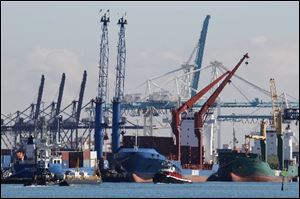
U.S. trade deficit widens
3/10/2011
Containers are loaded onto vessels at the Port of Miami.
The gap in goods and services increased 15 percent to $46.3 billion, from $40.3 billion in December, Commerce Department figures showed Thursday in Washington. Imports jumped 5.2 percent, the most since March 1993, while exports grew 2.7 percent. The deficit was wider than the most pessimistic forecast in a Bloomberg News survey.
Imports were the highest since August 2008, reflecting a jump in oil prices and purchases of business equipment and consumer goods that may be sustained as the world’s largest economy expands. Exports of American-made goods are getting a boost from the weaker dollar and growth in Asia and Latin America, benefiting companies like Deere & Co.
“There’s no doubt the trade deficit will continue to widen through the quarter,” said Chris Low, chief economist at FTN Financial in New York. “The big increase in oil prices could cause some temporary pain. Companies are betting that demand will continue to be strong this year,” which will fuel gains in non- oil imports, he said.
The median estimate in a Bloomberg News survey was for a January deficit of $41.5 billion. Estimates of 74 economists ranged from $39 billion to $46 billion after a previously reported December shortfall of $40.6 billion.
Jobless Claims Rise
First-time claims for jobless benefits rose more than forecast last week from an almost three-year low, highlighting the uneven nature of the improvement in the labor market.
Applications for unemployment benefits increased by 26,000 to 397,000 in the week ended March 5, the Labor Department said Thursday. Economists forecast claims would climb to 376,000, according to the median estimate in a Bloomberg survey.
Stock-index futures extended losses after the claims figures, with the March contract on the Standard & Poor’s 500 Index dropping 0.6 percent to 1,307.5 at 8:56 a.m. in New York. Treasuries rose, pushing down the yield on the benchmark 10-year note to 3.45 percent from 3.47 percent late Wednesday.
Exports increased to $167.7 billion, boosted by record shipments of industrial supplies and more deliveries of motor vehicles and food.
Imports climbed to $214.1 billion from $203.6 billion in the prior month. Purchases of capital goods rose to a record $41.7 billion in January, while auto imports were the highest since February 2008.
Effect on Growth
Faster import growth explains why the trade balance may keep widening. Net exports helped to reduce the gap in the fourth quarter, adding 3.4 percentage points to economic growth, the most since 1980, Commerce Department figures showed last month. The U.S. grew at a 2.8 percent annual rate in the period.
The January trade figures showed the U.S. imported 290.7 million barrels of crude oil, the most since August. The value of oil imports increased to $24.5 billion from $22.5 billion. The average price per barrel of imported crude reached $84.34, the highest since October 2008.
Even after eliminating the influence of prices, which are the numbers used to calculate gross domestic product, the trade deficit widened to $49.5 billion from $46 billion.
The trade gap with China grew to $23.3 billion from $20.7 billion as imports rose and U.S. exports declined.
The U.S. shortfall with OPEC nations widened to $9.9 billion as imports increased to the highest level since October 2008.
Higher Oil
Crude oil prices are climbing as escalating violence in Libya raises concern that supply disruptions may spread through the region. Crude oil for April delivery was $104.37 a barrel Wednesday at the close of floor trading on the New York Mercantile Exchange. The contract touched $106.95 on March 7, the highest intraday price since Sept. 26, 2008.
The trade gap with the European Union and Japan narrowed in January, Thursday’s report showed. The trade deficit with Canada shrank, while the gap with Mexico widened.
Since reaching a one-year high on June 7, the dollar has fallen 9 percent against a trade-weighted basket of currencies. The drop makes American goods cheaper to buyers abroad and may keep spurring manufacturing, which expanded in February at the fastest pace since May 2004, according to the Institute for Supply Management’s factory index.
Among firms expanding overseas operations is Deere, the world’s largest maker of agriculture equipment. The Moline, Illinois-based company last month announced plans to almost double sales to $50 billion by 2018 by expanding outside the U.S.
Emerging Markets
“Where our efforts are going to be focused is in places like Asia, South America, and in addition to continuing to extend our position in North America,” Chief Financial Officer James M. Field said in a March 8 presentation. Deere got 35 percent of sales from outside the U.S. and Canada in the fiscal year ended Oct. 31.
Overseas demand is being complemented by a pickup in consumer spending, the biggest part of the U.S. economy, which is prompting companies to replenish inventories.
President Barack Obama, who has set a goal of doubling American exports in five years, Wednesday said he will nominate Commerce Secretary Gary Locke to be the next U.S. ambassador to China, putting him at the forefront of managing one of the nation’s “most critical” relationships.
China’s trade surplus with the U.S. remains a thorny subject. China’s economy passed Japan’s to become the world’s second-largest last year, and the Asian nation is the second- biggest U.S. trading partner after Canada.